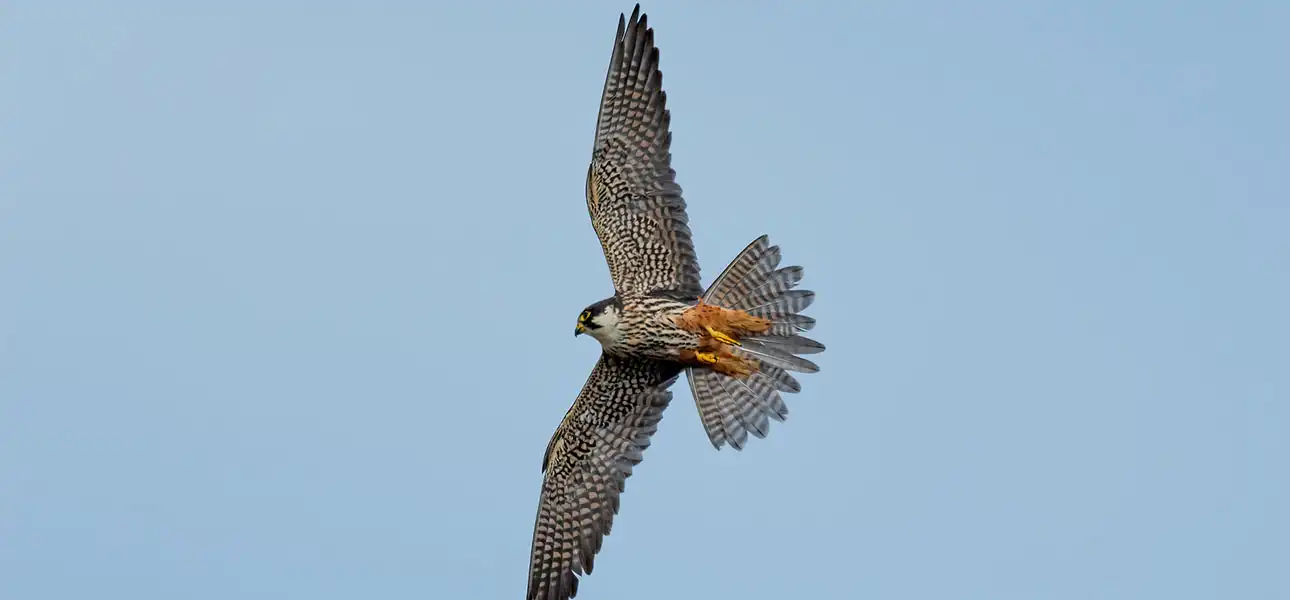
Until recently Hobbies were a scarcely encountered species away from the south coastal heathlands that were this dashing falcon’s usual haunts. Over the last couple of decades, numbers have risen, and they can now be found in farmland and over our towns and cities. It has also become a defining sign of spring at wetland reserves, as it stocks up on large aerial insects before moving on to its breeding sites, which are almost inevitably in the tops of trees, usually in old Carrion Crow nests. Relatively small clumps of trees, hedge lines or even isolated large trees will be used, but not woodland, as this is a bird of open country.
Key facts
Common name: Hobby
Scientific name: Falco subbuteo
Habitat: Wetland areas, lowland farmland, open countryside
Diet: Dragonflies, damselflies and small birds
Size: Average 33cm, wingspan 87cm. Females (240g) somewhat larger than males (180g)
Status: Long-distance migrant breeding bird
Population size: 2,050 pairs
Conservation status: GREEN (least concern). The number and range of Hobby have been expanding in recent years, possibly due to the increasing number of gravel pits and reservoirs which harbour their dragonfly prey.
Appearance
Hobbies are similar in size to the more familiar Kestrel, but have a very different silhouette, with long, rakish wings and a relatively shorter tail. Some think this gives the Hobby an ‘anchor’ shape in flight. Flight is often fast, level and direct but, when hunting, Hobbies are incredibly agile. They do not hover. When the plumage is seen well, they could be mistaken for small Peregrines, sharing the grey back and black hood, but Hobbies have distinctive red thighs and belly and heavily marked underparts. The shining white cheek is often visible from a great distance.
Lifespan
Average in the wild of 5 years. Adults have a 75% year-to-year survival rate. Less than half of the juveniles will survive their first year. The oldest known wild bird was almost 15 years old (ringing recovery).
Nesting
Clutches are laid from the end of May to early July, to enable their young to learn independence when there are many young, inexperienced Swallows, Martins and Swifts about. They only have one brood per year. Hobbies usually nest in trees, often in old Crow nests. Hobbies start to breed at two years of age and will spend their first summer back on the breeding grounds learning about the local environment and hunting opportunities.
Number of eggs: 2-3
Incubation: 31-33 days
Fledging time: 29 days
Habitat and Distribution
Hobbies are found throughout much of England up to a line between Northumberland and Lancashire, as well as in the lowland parts of Wales. Occasional birds are found in Scotland, but the species is still a very scarce, non-breeding, visitor to Ireland. Hobbies have a wide distribution in Europe and across to Asia and China. They winter in southern Africa, with birds from further east in the range wintering in India and S.E. Asia.
Movements
Hobbies are highly migratory. Birds start arriving in mid-April, with the first birds often noted at wetland reserves where they feed on early damsel and dragonflies. Most have left again by mid-September, heading back to their African wintering grounds.
Feeding
Hobbies are aerial hunters, being incredibly agile and fast in pursuit of their insect or bird prey. Early in the season they feed almost exclusively on dragonflies and damselflies which they catch elegantly in their feet before transferring them to their mouths in flight, in a highly distinctive movement. At some wetland reserves large numbers of Hobbies can be found hunting together. Birds form a large part of their diet, and they will go after any small birds, but specialise in Swallows, martins and even Swifts, which are chased and caught in very fast and dramatic hunting flights. When hunting their prey, Hobbies often adopt active camouflage by sweeping their wings back and flying in a similar way to their prey, allowing them to make a closer approach before being spotted. Hobbies are often encountered in urban areas, which they are likely to visit on hunting expeditions, lured by the large congregations of Swifts. Listen out for a sudden change in the sound of the Swifts when a Hobby is spotted.

